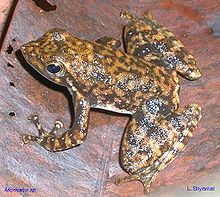Rapids frogs
The division of living beings into systematics is a continuous subject of research. Different systematic classifications exist side by side and one after the other. The taxon treated here has become obsolete due to new research or is not part of the group systematics presented in the German-language Wikipedia.
As rapids Frogs (Engl. Torrent frogs ) are frogs called that occur in fast-flowing waters and waterfalls, where their larvae ( tadpoles ) develop. Because of their similar way of life and some external characteristics, several frog genera from Africa and Asia that occur in these habitats have been put together in a separate family Petropedetidae . However, it turned out that these frogs are not as closely related in ancestral terms as originally assumed. However, due to their way of life in rapidly flowing water, they went through a convergent development in the course of evolution , which led to the formation of similar characteristics.
features
Morphological adaptations of the rapids are the flat, aerodynamic body shape, pointed skull shapes, which are often reflected in the scientific species names such as nasica and nasutus , as well as long row legs and toes with mostly large webbed feet. The adult animals of some species, for example the Lolokou cascade frog ( Amolops loloensis ) or the genus Odontobatrachus have widened adhesive discs on the finger and toe ends, similar to the tree frogs, with which this genus is not closely related. Some species that live near waterfalls have developed additional communication options such as ultrasound or webbed signals.
The eggs of the rapids frogs are usually pinned in small groups to stones on the bottom of the water. The tadpoles have a large suction cup in the mouth or stomach region to find hold on stones in the rushing current.
Occurrence
The following species of frog are referred to as rapids frogs:
- In Asia, the cascade frogs ( Amolops ) and the genera Huia , Meristogenys , Sumaterana and Clinotarsus , whose larval stages have suction discs on their belly, are counted among the rapids frogs because of their way of life. All of these genera belong to the family of real frogs (Ranidae). In addition there are the genera Indirana from the family Ranixalidae , Micrixalus from the family Micrixalidae and Nanorana from the family Dicroglossidae .
- The African rapids frogs Arthroleptides , Odontobatrachus and Petropedetes are today type genera of the families named after them.
- In Australia, the genus Taudactylus from the family of the Australian southern frogs (Myobatrachidae) is referred to as rapids frogs .
Systematics and tribal history
Before the use of molecular genetic methods to investigate genealogical relationships, external characteristics were often misjudged. This led to the compilation of "hunt groups" which have only recently been able to be systematically divided. Originally all rapids frogs belonged to the family of real frogs. The Petropedetidae family was re-established for some frog genera from Africa and Asia .
In 2006, however, the genus Indirana , which occurs in India, was spun off into a separate family called Ranixalidae . The genus Conraua received the rank of an independent family in 2011. After Arthroleptides was moved to the newly created family long-fingered frogs (Arthroleptidae), only the genus Petropedetes remained within the Petropedetidae . For the original as Petropedetes natator also in the genus Petropedetes classified petropedetes natator was in 2014 also built their own family. For the line of development of Odontobatrachus , a separation from the other families was already calculated for the Cretaceous , i.e. within the Mesozoic Ages more than 65 million years ago.
Individual evidence
- ↑ Umilaela Arifin, Utpal Smart, Stefan T. Hertwig, Eric N. Smith, Djoko T. Iskandar, Alexander Haas: Molecular phylogenetic analysis of a taxonomically unstable ranid from Sumatra, Indonesia, reveals a new genus with gastromyzophorous tadpoles and two new species. Zoosystematics and Evolution, 64, 1, pp. 163-193, March 2018
- ↑ I. Van Bocxlaer, K. Roelants, SD Biju, J. Nagaraju, and F. Bossuyt: Late Cretaceous vicariance in Gondwanan amphibians. PLoS (Public Library of Science) One, 1, pp. 1-6, 2006
- ^ RA Pyron & JJ Wiens: A large-scale phylogeny of Amphibia including over 2800 species, and a revised classification of advanced frogs, salamanders, and caecilians. Molecular Phylogenetics and Evolution, 61, pp. 543-583, 2011
- ^ George Albert Boulenger: Descriptions of new West-African frogs of the genera Petropedetes and Bulua. Annals and Magazine of Natural History, Series 7, 15, pp. 281-283, 1905, pp. 282
- ↑ Michael F. Barej, Andreas Schmitz, Rainer Günther, Simon P. Loader, Kristin Mahlow & Mark-Oliver Rödel: The first endemic West African vertebrate family - a new anuran family highlighting the uniqueness of the Upper Guinean biodiversity hotspot. Frontiers in Zoology, 11, p. 8, 2014
literature
- Michael F. Barej, Mark-Oliver Rödel, Simon P. Loader, Michele Menegon, Legrand Nono Gonwouo, Johannes Penner, Václav Gvoždík, Rainer Günther, Rayna C. Bell, Peter Nagel & Andreas Schmitz: Light shines through the spindrift - phylogeny of African torrent frogs (Amphibia, Anura, Petropedetidae) . Mol. Phyl. Evol. 71, pp. 261–273, 2014 (first description of the genre)
- George Albert Boulenger: Descriptions of new West-African frogs of the genera Petropedetes and Bulua. Annals and Magazine of Natural History, Series 7, 15, pp. 281-283, 1905
Web links
- Berlin researchers discover new family of rapids frogs in West Africa Vet-Magazin.com from February 4, 2014, accessed on February 26, 2014 (with photos)


